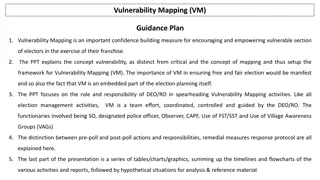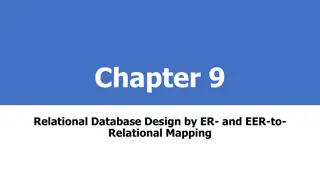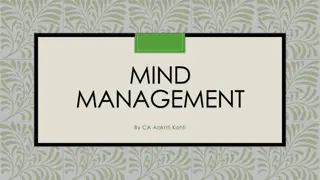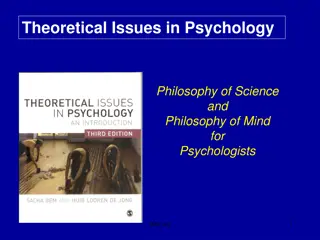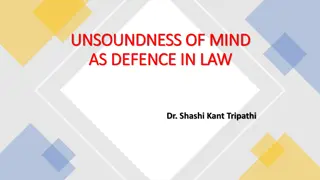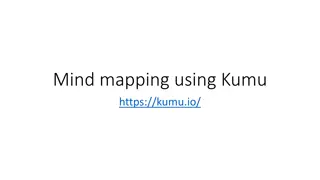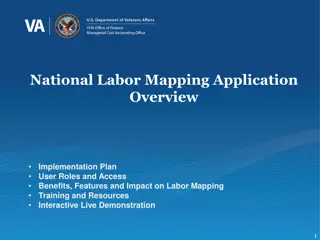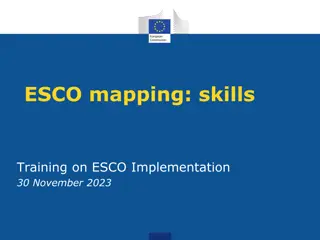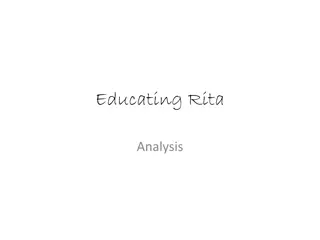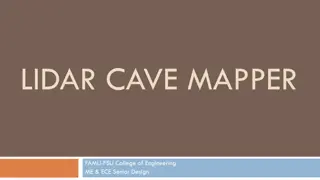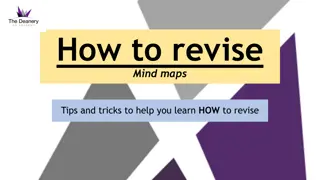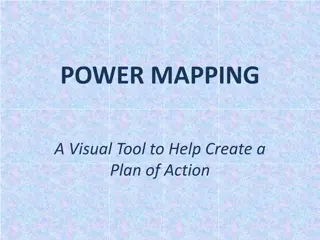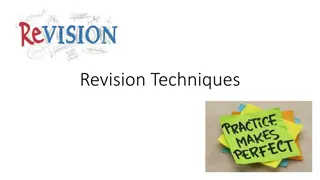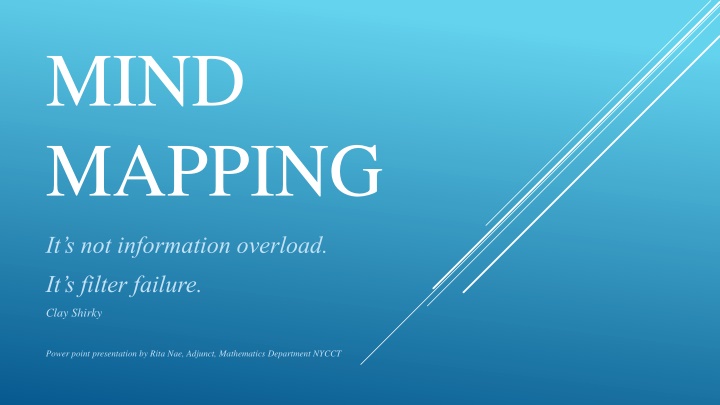
Implementing Mind Mapping in Education: Benefits, Strategies & Research
Enhance learning with Mind Mapping by organizing information visually, improving memory retention, and promoting analytical thinking. Discover key properties, benefits, and research supporting the effectiveness of Mind Mapping in education.
Download Presentation

Please find below an Image/Link to download the presentation.
The content on the website is provided AS IS for your information and personal use only. It may not be sold, licensed, or shared on other websites without obtaining consent from the author. If you encounter any issues during the download, it is possible that the publisher has removed the file from their server.
You are allowed to download the files provided on this website for personal or commercial use, subject to the condition that they are used lawfully. All files are the property of their respective owners.
The content on the website is provided AS IS for your information and personal use only. It may not be sold, licensed, or shared on other websites without obtaining consent from the author.
E N D
Presentation Transcript
MIND MAPPING It s not information overload. It s filter failure. Clay Shirky Power point presentation by Rita Nae, Adjunct, Mathematics Department NYCCT
Driving force behind the idea of implementing Mind Mapping in my classroom - common student complains: Too much information; Disconnect between the topics; around the time of midterm I don t remember where did we even start..
What is Mind Mapping? Visual tool used to collect, organize and manage information in a hierarchical order.
It represents information via spatial organization of concepts/topics, ideas, words, or other items linked to and arranged in a radial pattern around a central concept/topic. (Toni Krasnik, 2012) (1) 1)
Key properties that I used for Mind mapping so far: It should take less than 5 min to recreate entire map; Map has to fit in one page; Do it by hand versus software; 4 - 5 colors to represent major branches; Redraw and update the map every other class.
Benefits of Mind Mapping: Processing of unstructured information into systematic framework; Less memorization, more analytic thinking; Simple & easy to use; Can be used for any other class or project; Clarity.
Disadvantages: Might not be preferred by auditory or kinesthetic learners; It works the best when a creator of a map is also the user; Maybe a limiting learning tool if a structure or framework is imposed to the student by the teacher.
Some research Mind Mapping was selected as an effective strategy for encouraging creativity development in engineering students(Zampetakis et al, 2007) (2) A study by Abi-El-Mona and Adb-El-Khalick (2008) (3) revealed that science students who used Mind Mapping achieved substantially higher gains in conceptual understanding and practical reasoning than students using conventional study techniques. Mind Mapping has been shown to bring a renewed sense of enthusiasm to the classroom because it increases student confidence and sense of skill in mastering assigned materials (Mento et al, 1999) (4) Concentration: Evidence includes improved concentration, staying on task for longer periods of time, improved questioning and answering during class discussions and improved independence. Cain (2001/2002) (5)
The illiterate of the 21st century will not be those who cannot read and write, but those who cannot learn, unlearn, and relearn. Alvin Toffle
Mind Mapping tips http://lifehacker.com/how-to-use-mind-maps-to-unleash-your-brains-creativity-1348869811
Resources: 1. HOW TO STUDY WITH MIND MAPS: THE CONCISE LEARNING METHOD FOR STUDENTS AND LIFELONG LEARNERS (EXPANDED EDITION) KINDLE EDITION, 2012. 2. ZAMPETAKIS, L. A., TSIRONIS, L. AND MOUSTAKIS, V. (2007), CREATIVITY DEVELOPMENT IN ENGINEERING EDUCATION: THE CASE OF MIND MAPPING . JOURNAL OF MANAGEMENT DEVELOPMENT, VOL. 26, NO. 4, PP 370-380. 3. ABI-EL-MONA, I. AND ADB-EL-KHALICK, F. (2008), THE INFLUENCE OF MIND MAPPING ON EIGHTH GRADERS SCIENCE ACHIEVEMENT . SCHOOL SCIENCE AND MATHEMATICS. MENTO, A. J., MARTINELLI, P. AND JONES R. M. (1999), MIND MAPPING IN EXECUTIVE EDUCATION: APPLICATIONS AND OUTCOMES . THE JOURNAL OF MANAGEMENT DEVELOPMENT, VOL. 18, ISSUE 4. 4. 5. CAIN, M. E. (2001/2002), USING MIND MAPS TO RAISE STANDARDS IN LITERACY, IMPROVE CONFIDENCE AND ENCOURAGE POSITIVE ATTITUDES TOWARDS LEARNING . STUDY CONDUCTED AT NEWCHURCH COMMUNITY PRIMARY SCHOOL, WARRINGTON.

![[PDF⚡READ❤ONLINE] Zen Mind, Beginner's Mind: 50th Anniversary Edition](/thumb/20459/pdf-read-online-zen-mind-beginner-s-mind-50th-anniversary-edition.jpg)
